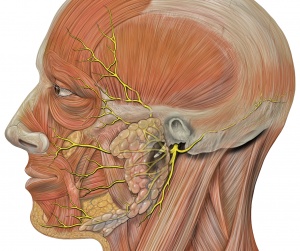Facial Palsy: Difference between revisions
Wendy Walker (talk | contribs) No edit summary |
Wendy Walker (talk | contribs) No edit summary |
||
| Line 16: | Line 16: | ||
*Idiopathic | *Idiopathic | ||
Bell's Palsy - cause not known <ref name="Peiterson 2002">Peiterson,E. Bell's Palsy; the spontaneous course of 2,500 peripheral facial nerve palsies of different etiologies. Acta Oto-Laryngologica. Supplementum 2002;549:4-30</ref> | Bell's Palsy - cause not known <ref name="Peiterson 2002">Peiterson,E. Bell's Palsy; the spontaneous course of 2,500 peripheral facial nerve palsies of different etiologies. Acta Oto-Laryngologica. Supplementum 2002;549:4-30</ref> but possibly linked to Herpes Simplex infection <ref>Holland NJ, Weiner GM. Recent developments in Bell's Palsy. BMJ 2004; 329(7465):553-7</ref> | ||
Ramsey Hunt Syndrome | Ramsey Hunt Syndrome - linkied to Herpes Zoster infection | ||
*Tumour | *Tumour | ||
Revision as of 00:52, 13 September 2013
Original Editor - Your name will be added here if you created the original content for this page.
Lead Editors
Clinically Relevant Anatomy
[edit | edit source]
The VIIth cranial Nerve originates in the Pons
Mechanism of Injury / Pathological Process
[edit | edit source]
Causes of Facial Palsy:
[edit | edit source]
- Idiopathic
Bell's Palsy - cause not known [1] but possibly linked to Herpes Simplex infection [2]
Ramsey Hunt Syndrome - linkied to Herpes Zoster infection
- Tumour
A tumor compressing the facial nerve can result in facial paralysis, but more commonly the facial nerve is damaged during surgical removal of a tumour. The most common tumour to result in facial palsy during surgical removal is the Acoustic Neuroma (AKA Vestibular Schwannoma). Less commonly, cholesteatoma, hemangioma, Facial Neuroma or partotid gland tumours are the cause.
- Rare causes include
Neurosarcoidosis, ototis media, Multiple Sclerosis, Moebius Syndrome
- The facial nerve can also be damaged by trauma, especially temporal bone fractures
Clinical Presentation[edit | edit source]
Paralysis of the muscles supplied by the Facial Nerve presents on the affected side of the face as follows:
Appearance and range of movement:[edit | edit source]
Inability to close the eye
Inability to move the lips eg. into smile, pucker
At rest, the affected side of the face may "droop"
Functional effects:[edit | edit source]
Difficulty eating and drinking as lack of lip seal makes it difficult to keep fluids and food in the oral cavity
Reduced clarity of speech as the "labial consonents" (ie. b, p, m, v, f) all require lip seal
Differential Diagnosis, UMN versus LMN:[edit | edit source]
If the forehead is not affected (ie the patient is able to raise fully the eyebrow on the affected side) then the facial palsy is likely to be a result of a lesion in the Upper Motor Neuron (UMN). Paralysis which includes the forehead, such that the patient is unable to raise the affected eyebrow, is a Lower Motor Neuron (LMN)lesion.
Diagnostic Procedures[edit | edit source]
Laboratory investigations include an audiogram, nerve conduction studies (ENoG), computed tomography (CT) or magnetic resonance imaging (MRI), electromyography (EMG).
Outcome Measures[edit | edit source]
add links to outcome measures here (see Outcome Measures Database)
Management / Interventions
[edit | edit source]
add text here relating to management approaches to the condition
[edit | edit source]
Key Evidence[edit | edit source]
add text here relating to key evidence with regards to any of the above headings
Resources
[edit | edit source]
add appropriate resources here
Case Studies[edit | edit source]
add links to case studies here (case studies should be added on new pages using the case study template)
Recent Related Research (from Pubmed)[edit | edit source]
Extension:RSS -- Error: Not a valid URL: Feed goes here!!|charset=UTF-8|short|max=10
References[edit | edit source]
References will automatically be added here, see adding references tutorial.







